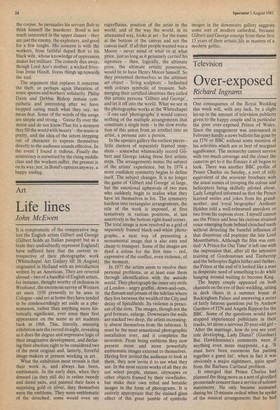Art
Life lines
John Mc Ewen
It is symptomatic of the comparative neglect the English artists Gilbert and George (Gilbert holds an Italian passport but as a team they undoubtedly represent England) have suffered here that the current retrospective of their photographic work (Whitechapel Art Gallery till 16 August) originated in Holland with an introduction written by an American. They are revered abroad — two of a handful of English artists, for instance, thought worthy of inclusion in Westkunst, the enormous survey of Western art since 1939 presently to be seen in Cologne — and yet at home they have tended to be condescendingly set aside as a phenomenon, rather than anything more historically significant, ever since their first appearance on the scene as art students back in 1968. This, literally, stunning exhibition sets the record straight, revealing as it does the degree and impressive logic of their imaginative development, and declaring their absolute right to be considered two of the most original and, latterly, forceful image-makers at present working in art.
What the exhibition most reveals is that their work is, and always has been, emblematic. In the early days, when they dressed (as they still do) in rather tweedy and dated suits, and painted their faces a surprising gold or silver, they themselves were the emblems. They were emblematic of the detached, some would even say superfluous, position of the artist in the world; and of the way the world, in its attenuated way, looks at art — for the name at the bottom of the canvas and not the canvas itself. If all that people wanted was a Moore — never mind of what or at what price, just so long as it genuinely carried his signature — then, logically, the ultimate prize, the ultimate artistic possession, would be to have Henry Moore himself. So they presented themselves as the ultimate art object — 'living sculptors' — bedaubed with colours symbolic of treasure. Submerging their certified identities they called this artistic persona 'Gilbert and George', and let it off into the world. What we see in the photographic works at the Whitechapel — if one said 'photographs' it would convey nothing of the multiple arrangements that constitute a single item — is the slow evolution of this union from an artefact into an artist, a persona into a person.
In the upstairs gallery the earliest pieces — little clusters of separately framed snapshots — somewhat whimsically record Gilbert and George taking these first artistic steps. The arrangements mimic the subject of the artists' experience, but by 1974 a more confident symmetry begins to define itself. The subject changes. It is no longer the game of 'Gilbert and George' at large, but the emotional upheavals of two men who suddenly begin to realise what they have let themselves in for. The symmetry hardens into rectangular arrangements, the title of the work is imposed, at first tentatively in various positions, at last assertively in the bottom right-hand corner. The total image is now resolved as a grid of separately framed black-and-white photographs, a neat way of presenting a monumental image that is also easy and cheap to transport. Some of the images are dyed a colour for the first time — red, expressive of the conflict, even violence, of the moment.
In 1977 the artists seem to resolve their personal problems, or at least ease them through identification with the outside world. They photograph the inner city strife of London — angry graffiti, down-and-outs, the flotsam and jetsam of the tideline where they live between the wealth of the City and decay of Spitalfields. Its violence is prescient of the riots. The images, though not the grid formats, enlarge. Downstairs the walls are stacked two deep, the artists increasingly absent themselves from the tableaux. It must be the most sensational photographic installation ever, and it completes the inversion. From being emblems they now present more and more powerfully emblematic images external to themselves. Having first invited the audience to look at them, they now invite it to see what they see. In the most recent works of all they do not select people, statues, cityscapes or other objects framed by their viewfinder, but make their own tribal and heraldic images in the form of photograms. It is entirely appropriate that the stained glass effect of this great jumble of symbolic images in the downstairs gallery suggests some sort of modern cathedral, because Gilbert and George emerge from these first 13 years of their artistic life as masters of a modern gothic.


































 Previous page
Previous page